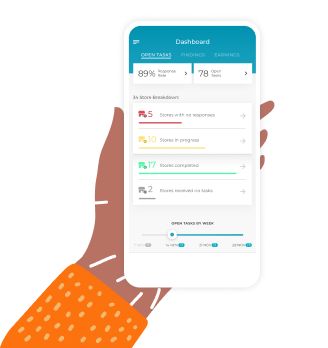Much of the in-store technology currently spreading throughout the brick-and-mortar space is highly visible to customers. But what about the innovations that aren’t so obvious? Sure, apps and in-store pickup make life easier for consumers and draw in new ones. But some of the most exciting developments around in-store technology are almost unseen by the majority of shoppers.
Since most brick-and-mortar customers interact with stores much in the same way they always have, it’s important for retailers to find ways to more subtly drive sales and reduce waste. A truly innovative company won’t just roll out big new features to customers, but will constantly find new ways to make their business run better at each level. By leveraging both existing and emerging in-store technology, retail operations teams are finding new ways to streamline their businesses as well as improve productivity and efficiency.
Smartphones Over Scanners
It’s an almost ubiquitous feature of modern retail: the humble handheld terminal. These rugged little devices are used to scan product and shelf labels, both on and off the sales floor, enabling workers to access all kinds of information and complete various tasks without having to spend time locked down behind a computer. Properly equipped, associates and managers can check on-hands, make inquiries about other stores in their district, and even order product right from the handheld terminal. There are, of course, downsides. These devices are often clunky and unintuitive, running older operating systems and featuring rudimentary touchscreens along with little to no Internet access.
Samsung and other tech companies are offering a different solution. By replacing these items with smartphones, retailers can put more powerful and flexible tools in the hands of their employees. These devices are easier to use, and can run a multitude of apps (such as CB4) which can have noticeable positive effects on both day-to-day operations as well as sales and productivity over time.
Feeling The Heat
Heat maps have been useful tools for a while now. By providing information on where the most foot traffic is, what customers are looking at, and how much time is spent in areas around the store, heat maps can offer suggestions for merchandise and operations adjustments in order to drive sales. Now, we’re seeing expanded applications of this in-store technology. Machine learning artificial intelligence apps like Dragonfly can provide insight by simulating brain activity in order to give an idea of how efficient a design or set is. This means that retailers can get a preliminary idea of how effective their set is before it’s even done. Meanwhile, innovations in virtual reality allow for heat maps to be generated in virtual spaces, potentially allowing focus groups to test out new store concepts and compare for effectiveness. Applications like these can make it easier for teams to make decisions and adjustments, sometimes before a customer even sets foot in the store.
Finally, A Better Shelf Tag
Chances are, most customers don’t give a second thought to the price tags on shelves. While they do care about accuracy and readability, so long as they can figure out what the price is there’s not much for them to concern themselves over. However, these standard features of nearly every store can actually be a great vector for innovation. As anyone who’s done a price change or reset can tell you, handling hundreds of those little paper tags can be time-consuming and inefficient. And over time, it’s inevitable that product will be moved around as the area is shopped and merchandising edits are made.
That’s where electronic shelf tags come in. By replacing paper with e-ink or LCD displays, it’s easier than ever to adjust prices and do resets. As seen with Kroger’s new Edge rollout, it’s also possible for customers to interact with these tags, displaying nutrition information and other valuable data. When combined with in-store apps, these devices can be powerhouses which both improve productivity and make life easier for customers. And as in-store technology improves, it gets easier to make changes and introduce new features to a system such as this.
Better Operations Through Machine Learning
One more way retailers can improve is by leveraging machine learning at point-of-sale. By tapping into the rich vein of POS data each store generates, CB4 can track local demand and make suggestions to better drive sales. Through patented machine learning algorithms, this application can identify items which are not reaching their sales potential, then pinpoint operational issues which in turn create opportunities for store managers to act on. These improvements create return business through a better customer experience. Stores using CB4 have seen growth of 0.8% to 3% on average. Implementation is quick and painless, and results take only a couple days. Overall, it’s a great way for brick-and-mortar retailers to identify existing issues and get the most out of their operations teams.
To learn more about how retailers use CB4, take a look at our Content Library, where you’ll find product overviews, case studies and more.



